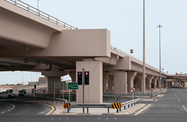Enhancing surface transport connectivity to neighbouring countries, the region and the rest of the world is a central priority for Bahrain. In addition to the development of internal transportation, the government has identified the importance of new road and rail links to Saudi Arabia and Qatar to strengthen the country’s trade position and support its economic diversification.
In February, Bahrain and neighbouring Saudi Arabia signed an agreement giving the go-ahead to a $4.5bn rail link between the two countries. Construction is due to start in 2014, after engineering designs are completed late this year or in early 2013. Completion of the railway is expected by 2017.
The project is part of the broader 2200-km GCC railway, which will link Kuwait in the north to Oman in the south, with branches connecting the island of Bahrain and the peninsula of Qatar. The GCC project’s cost is currently estimated at $15.5bn, having been forecast previously to be between $25bn and $30bn. Overall, the six GCC member states are investing around $100bn in railways, including domestic systems, with several countries developing networks from scratch.
The Bahrain railway will connect both to the GCC network and to the Saudi rail “Landbridge” that will connect the city of Dammam, adjacent to Bahrain on the Gulf coast, with Jeddah on the Red Sea through Riyadh. In the future, these lines will be linked to a broader Middle East rail system, and then Europe and potentially Central Asia.
The Saudi-Bahrain link will be partly funded by the two governments, but private investors are also likely to be invited to participate.
Having a railway connection to the rest of the region is expected to bring a range of benefits to Bahrain. Firstly, it will make moving heavy cargo easier and cheaper, thus improving trade overall. It will also make it easier for Bahrain’s growing manufacturing industries to export, as well as facilitate imports of bulkier goods and commodities.
Importantly, the railway should take some pressure off Bahrain’s roads, particularly the economically vital King Fahd Causeway (KFCW), which is currently undergoing upgrades. The 26-km causeway to Saudi Arabia currently handles an average of 45,000 vehicles per day, with volumes reaching 60,000 at weekends. A roadway designed for 150 lorries per day now routinely sees 1200, and limited parking space on the Bahraini side can lead to delays.
The railway between Bahrain and Dammam will run parallel to the KFCW across the Gulf of Bahrain, and a substantial amount of the traffic currently taking the causeway is likely to transfer to the rails. The KFCW itself is also due to be expanded under a $5m plan approved in July 2010, which foresees increasing the number of arrival lanes from 13 to 18 and departure lanes from 10 to 17, a move that is expected to ease bottlenecks considerably.
Perhaps the most high-profile surface transportation project currently in the works in Bahrain is the Qatar-Bahrain Causeway (QBC), also known as the Friendship Bridge, which is expected to carry both road and rail traffic. The long anticipated scheme would stretch approximately 42 km, including 34 bridges and 6 km of causeway, making it the longest fixed link in the world. The road section is expected to cost around $3bn.
The construction has been delayed for various reasons, including having to rework the design to accommodate a rail link, but momentum is building behind the project again, partly due to Qatar’s obligation to complete infrastructure in the run-up to its hosting of the 2022 FIFA World Cup. In a report last year, the Qatari government pledged to push ahead with the QBC as one of several important transportation schemes.
The QBC is expected to cut road travel time from Bahrain to Qatar from five hours to one hour, making the trip viable as a commute. Bahrain’s government and business leaders are likely to be hoping that the link encourages visitors from fast-growing Qatar to come to Manama for business, tourism and potentially to use Bahrain as an access point to Dammam and nearby Saudi cities.
Improved connectivity should help reduce costs for the Bahraini economy and help stimulate the growth of a number of important sectors, from manufacturing through tourism to financial services. Transportation projects are by their nature long-term and capital intensive, and their international nature adds a degree of complexity. It will be some time before Bahrain’s new regional rail and road links are complete, but their potential to support further economic development is considerable.

